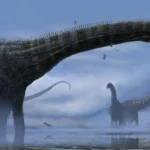Long-necked dinosaurs, often referred to as sauropods, are among the most iconic and awe-inspiring creatures to ever walk the Earth. These colossal herbivores, with their towering necks, have captured the imagination of both paleontologists and the general public alike. Known for their massive bodies and distinctive long necks, these dinosaurs are a testament to the incredible diversity of life during the Mesozoic Era, over 65 million years ago. But what exactly are long-necked dinosaurs, and what made them so unique?
What Are Long-Necked Dinosaurs?
Long-necked dinosaurs, as the name suggests, are a group of dinosaurs distinguished by their unusually long necks. These necks, sometimes exceeding 30 feet, were composed of numerous vertebrae—sometimes as many as 15 or more. These remarkable creatures belong to the broader group of sauropods, a suborder of large, herbivorous dinosaurs that dominated the landscapes of the Triassic, Jurassic, and Cretaceous periods.
Sauropods, which include some of the largest land animals to have ever existed, were characterized not only by their long necks but also by their other defining features:
- Large bodies: Most long-necked dinosaurs were massive, with some species growing to lengths of over 100 feet.
- Small heads: In comparison to their massive bodies, these dinosaurs had relatively small heads, often no larger than a car.
- Column-like legs: Their legs were thick and strong, capable of supporting their enormous weight.
- Long tails: These dinosaurs often had long, whip-like tails, which balanced their bodies and helped with movement.
Why Did Long-Necked Dinosaurs Evolve Such Long Necks?
The evolution of such long necks in dinosaurs has been a subject of fascination and study for paleontologists. While several theories attempt to explain the advantages of this unique adaptation, the most widely accepted explanation is related to feeding behavior.
- Feeding on High Vegetation: One of the main reasons for the evolution of long necks is the ability to reach food sources that were out of reach for other herbivores. The long neck allowed these dinosaurs to browse on treetops and tall plants, giving them access to food that was otherwise unavailable to shorter-necked species. By stretching their necks high into the trees, sauropods could consume vast amounts of vegetation without having to move their large bodies too much.
- Efficiency in Foraging: A long neck also enabled these giants to cover large areas of land in search of food without having to move as far. This would have been particularly useful in environments where food was widely distributed, allowing the sauropods to remain in one area while still having access to abundant food sources.
- Mating and Display: Some researchers believe that long necks may have evolved, in part, for display purposes, much like the colorful feathers of modern birds or the antlers of certain mammals. Mating displays, dominance displays, or social signaling could have been important factors in the development of these long necks.
- Thermoregulation: Another possibility is that long necks helped with thermoregulation, or the regulation of body temperature. Larger animals with fewer extremities tend to be better at conserving heat, and the long neck could have played a role in helping distribute heat more evenly across the dinosaur’s body.
Famous Long-Necked Dinosaurs
Several species of long-necked dinosaurs are well-known for their size and distinctive features. Some of the most famous and iconic sauropods include:
- Brachiosaurus: Arguably one of the most recognizable long-necked dinosaurs, the Brachiosaurus had a neck that sloped upwards, allowing it to reach even taller trees and vegetation. Unlike many other sauropods, the Brachiosaurus’ forelimbs were longer than its hind limbs, giving it an upright posture. It could grow to lengths of up to 80 feet and lived during the Jurassic period.
- Apatosaurus: Known for its long tail and neck, the Apatosaurus was one of the largest herbivores of the Jurassic period. It was once mistaken for the Brontosaurus but is now considered a distinct species. With its massive body and long neck, it would have been an impressive sight in its time.
- Diplodocus: Another well-known sauropod, the Diplodocus had a neck and tail that were both remarkably long, contributing to its overall length of over 85 feet. It was one of the longest dinosaurs and likely used its neck to feed on low-lying plants as well as tall trees, making it an efficient forager.
- Argentinosaurus: One of the largest known dinosaurs, the Argentinosaurus could reach lengths of over 100 feet and weighed as much as 100 tons. This Cretaceous-period sauropod was not only long-necked but also incredibly massive, earning it a place in history as one of the most awe-inspiring creatures to have ever lived.
The Behavior and Lifestyle of Long-Necked Dinosaurs
Long-necked dinosaurs were primarily herbivores, relying on plants to sustain their massive size. Their diet consisted of a variety of vegetation, including ferns, conifers, and cycads. The long necks allowed them to feed on a variety of plants, often from trees and shrubs that were out of reach for other herbivores.
Despite their size, it is believed that sauropods likely traveled in herds for protection. While their size made them less vulnerable to many predators, their herding behavior would have provided safety against larger carnivores, such as the fearsome Tyrannosaurus rex. It is also likely that long-necked dinosaurs communicated with one another through sounds, postures, and even displays of strength.
The Extinction of Long-Necked Dinosaurs
Long-necked dinosaurs, along with many other dinosaur species, went extinct around 65 million years ago at the end of the Cretaceous period. The most widely accepted explanation for their extinction is the impact of a massive asteroid, which triggered dramatic climate changes. This, combined with volcanic activity and other environmental shifts, disrupted ecosystems and food chains, leading to the demise of the dinosaurs.
Though these massive creatures no longer roam the Earth, they left behind an enduring legacy in the form of fossils, which continue to provide valuable information about life in the distant past.

Conclusion
Long-necked dinosaurs, or sauropods, were among the most fascinating and awe-inspiring creatures to ever inhabit the Earth. With their massive bodies, towering necks, and impressive size, they ruled the landscapes of the Mesozoic Era for millions of years. The unique adaptations of long necks allowed them to feed on plants that other herbivores couldn’t reach and likely played a key role in their survival. Despite their extinction, long-necked dinosaurs remain a symbol of the incredible diversity and complexity of life that once thrived on our planet, leaving a lasting impression on the world of paleontology and popular culture alike.



